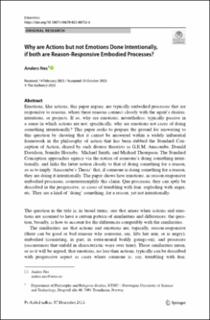| dc.description.abstract | Emotions, like actions, this paper argues, are typically embodied processes that are responsive to reasons, where these reasons connect closely with the agent’s desires, intentions, or projects. If so, why are emotions, nevertheless, typically passive in a sense in which actions are not; specifically, why are emotions not cases of doing something intentionally? This paper seeks to prepare the ground for answering to this question by showing that it cannot be answered within a widely influential framework in the philosophy of action that has been dubbed the Standard Conception of Action, shared by such diverse theorists as G.E.M. Anscombe, Donald Davidson, Jennifer Hornsby, Michael Smith. and Michael Thompson. The Standard Conception approaches agency via the notion of someone’s doing something intentionally, and links the latter notion closely to that of doing something for a reason, so as to imply ‘Anscombe’s Thesis’ that, if someone is doing something for a reason, they are doing it intentionally. The paper shows how emotions, as reason-responsive embodied processes, counterexemplify this claim. Qua processes, they can aptly be described in the progressive, as cases of trembling with fear, exploding with anger, etc. They are a kind of ‘doing’ something, for a reason, yet not intentionally. | en_US |

